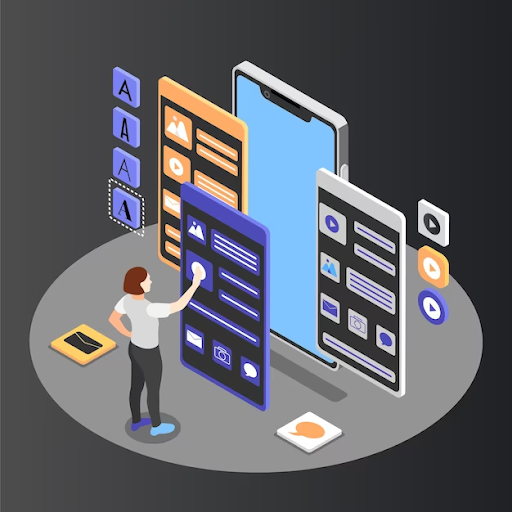Cross-platform iOS App Development: Comparing Approaches using Flutter, React Native, and Xamarin
 Sarah
Sarah
The utilization of cross-platform app development frameworks facilitates the execution of identical code across various operating systems. This article expansively explores the rationale behind opting for cross-platform mobile app development over native development. We delve into an assessment of the distinctive technologies employed in cross-platform app development while highlighting their comparative features.
We conduct a comparative analysis of React Native vs. Xamarin vs Flutter – three highly acclaimed frameworks for cross-platform mobile app development. Our assessment encompasses an evaluation of their architectural design, available tooling, and the diverse array of applications that can be created using these frameworks.
Why Opt for Cross-Platform Mobile Development?
Cross-platform iOS app development has often received criticism for various reasons. As everyone knows, there was an enormous lack of technology up until recently that made cross-platform development impossible, and what was there did not provide alternatives. These technologies imposed limitations on developers and significantly affected application performance to the point where the challenges of cross-platform development seemed unjustifiable.
Despite its drawbacks, many individuals have continued to choose cross-platform development over native development due to several advantages it brings:
Shortened Development Cycle
Cross-platform development enables sharing up to 96% of code across multiple platforms. This significantly reduces the development cycle. Developers just need to build one app, distribute its code across several operating systems, and make any required customizations for each platform. This eliminates the need for two distinct programs.
Cost Efficiency
Cross-platform iOS app development undoubtedly provides cost savings. It reduces the need for additional developers and results in fewer working hours. This advantage is particularly enticing for startups as it offers an economical solution.
Smaller Team
Cross-platform mobile app development eliminates the necessity of hiring separate teams with specialized knowledge in IOS app development and Android. Fewer developers are required, leading to a smaller overall team size.
Simplified Testing Process
The smaller code base in cross-platform development necessitates fewer tests. This allows quality assurance (QA) engineers to devote more time to each component of the application. The testing process becomes simplified and can achieve higher test coverage, enhancing the overall quality of the application.
Why choose Flutter?
Flutter, created by Google, is a readily available UI software development kit for crafting native applications primarily on mobile, web, and desktop platforms through a unified codebase. This open-source framework has garnered substantial acclaim from developers due to its exceptional qualities and benefits.
Advantages of Flutter
Hot Reload
With this functionality, developers may rapidly rebuild the application just as they would a web page. Flutter's hot reload is stateful, so developers can just resume where they left off rather than having to restart the program each time they make changes. This makes the Flutter design immediately apparent.
Single Codebase
By utilizing Flutter app development services, developers can write one codebase for both iOS and Android platforms, cutting down on development time and effort.
Rich Customization
Flutter offers a wide selection of widgets and customization options, empowering developers to craft visually captivating and refined apps.
Performance
Flutter's native code compilation guarantees exceptional performance, making it an ideal choice for building high-performing applications.
Strong Community
With Flutter, users can tap into a vibrant and active community, providing access to an array of resources, libraries, and plugins that facilitate development.
Disadvantages of Flutter
Inexperience
The first and biggest drawback is the framework's youth. Flutter needs to develop even if it was declared ready for commercial usage in May 2018. It will be impossible to predict where applications created using Flutter will be since there is no way to determine with certainty if the framework will succeed.
Limited Libraries
Although the library support for Flutter is continually enhancing, it may not offer as extensive an ecosystem of libraries as some other frameworks.
App Size
Flutter apps might have a larger file size compared to native apps due to the inclusion of the Flutter engine.
Why go for React Native?
React Native, created by Facebook, is a widely embraced open-source framework employed to construct mobile applications utilizing JavaScript and React. This framework has garnered extensive popularity owing to its proficiency and exceptional performance that closely resembles native apps.
Advantages of React Native
Familiar Language
Developers experienced in JavaScript can easily transition to React Native, minimizing the learning curve.
Reusability
React Native enables the reuse of components across iOS and Android platforms, ultimately reducing development time.
Large Community
The extensive and dynamic React Native community provides a wide selection of third-party libraries and plugins.
Native Performance
React Native applications deliver exceptional performance by rendering components as native views.
Fast Development
Similar to Flutter, React Native offers a hot reload feature that allows for quick development and testing.
Disadvantages of React Native
Bridge Overhead
React Native depends on a bridge for communication between JavaScript and native modules, potentially leading to performance slowdowns in more complex applications.
UI Inconsistencies
Attaining a flawless UI design across platforms can be difficult, as variances may arise between iOS and Android.
Dependency on Native Modules
Certain advanced functionalities may require the creation of custom native modules, which can consume significant development time.
Why choose Xamarin?
Xamarin is a popular and free open-source platform that specifically caters to developers who use C#. It enables them to create mobile applications with ease. With a large community of over 60,000 members, Xamarin provides a robust solution for overcoming the challenges of resource fragmentation in app development.
Advantages of Xamarin
C# Language
Companies having a history in C# development may make use of Xamarin as it allows developers to create iOS applications using their pre-existing C# knowledge. This compatibility makes Xamarin an appealing choice for such organizations.
Native Performance
Xamarin ensures superior performance as its apps are compiled into native code. This feature guarantees excellent speed and responsiveness.
Visual Studio Integration
Seamlessly integrating with Visual Studio, Xamarin app development services provide developers with a robust and powerful development environment. This integration enhances productivity and streamlines the development process.
Large Library Ecosystem
Xamarin's affiliation with the Microsoft ecosystem gives it access to a wide range of libraries and plugins. Developers now have access to a wide range of resources, enabling them to create products with rich features more efficiently.
Single Codebase
With Xamarin, developers can share significant portions of code across multiple platforms. This capability eliminates the need for duplicating efforts, saving development time and effort. Xamarin allows the flexibility to write platform-specific code when required, ensuring optimal performance for each platform.
Disadvantages of Xamarin
Learning Curve
For developers unacquainted with C# or the .NET ecosystem, Xamarin poses a slightly steeper learning curve.
Community Size
Although Xamarin boasts a committed community, it may not be as extensive as that of Flutter or React Native.
License Costs
Certain advanced Xamarin features mandate a paid license, thereby potentially augmenting project expenses.
The Comparison of Flutter, React Native, and Xamarin
The Flutter Vs React Native Vs Xamarin; there are several comparisons between these three.
Learning Curve
Flutter
Learning Flutter may present a moderate challenge, primarily due to its unique programming language, Dart. Hire flutter developers who are accustomed to more popular languages like JavaScript or Python might find Dart less familiar. Those who have worked with object-oriented languages before may find it easy to learn Dart.
React Native
Considered generally easy to learn for JavaScript developers, React Native utilizes JavaScript and React, both widely used technologies. Grasping React concepts such as component-based development and state management might require some time for developers who are new to these concepts.
Xamarin
The learning curve for Xamarin is higher than that of Flutter and React Native, particularly for those who are not acquainted with C# and the .NET environment. Initially, I acquired proficiency in C# and comprehended the platform-specific development aspects of Xamarin.iOS and Xamarin. Android can prove challenging.
Performance
Flutter
Flutter ensures exceptional performance by compiling code to native ARM code, resulting in seamless and highly responsive applications.
React Native
React Native achieves performance close to native applications through its bridge architecture, enabling efficient communication between JavaScript and native modules. However, slight performance overhead may occur due to this bridge.
Xamarin
Xamarin offers native performance as C# code is compiled into native binaries. This guarantees that Xamarin applications operate with identical speed and responsiveness as fully native applications.
Reusability
Flutter
Promoting code reuse on both the iOS and Android platforms is one of Flutter's main benefits. By writing code once, developers can effortlessly run it on multiple platforms. This implies that the concept of a single codebase is introduced, effectively minimizing the duplication of effort.
React Native
Code reusability is a major focus in React Native. It encourages developers to reuse components and modules, enabling significant portions of their codebase to be shared across various platforms. This practical approach reduces both development time and effort.
Xamarin
Xamarin provides code reuse through a common codebase, in contrast. It ensures efficiency by enabling developers to share data access code and business logic. Xamarin gives you the freedom to build platform-specific user interface code as required.
Community and Libraries
Flutter
Flutter features a flourishing community that continuously expands with a growing number of plugins and libraries available within the Flutter ecosystem. The community actively contributes to the advancement of the framework and offers a plethora of valuable resources.
React Native
Among cross-platform frameworks, React Native boasts one of the most extensive and active communities. It provides comprehensive support from third-party sources, simplifying the process of finding suitable libraries and solutions for diverse requirements.
Xamarin
Xamarin's dedicated community excels in its seamless integration into the Microsoft ecosystem. Developers can leverage the wealth of resources, documentation, and tools provided by Microsoft, making Xamarin particularly well-suited for enterprises invested in Microsoft technologies.
UI Customization
- Flutter
Flutter stands out in UI customization thanks to its extensive widget library. Developers can exert significant control over their application's appearance, enabling them to craft visually stunning and highly personalized interfaces.
- React Native
React Native presents satisfactory customization options, although achieving an immaculate UI might pose challenges due to variations specific to different platforms. Developers may need to invest additional effort in meticulously refining the user interface.
- Xamarin
Xamarin provides a flexible framework for tailoring platform-specific UI components. Developers are empowered to create native UI elements as required, granting them complete authority over the user interface design. Many iOS App Development Companies around the world use it.
Conclusion
The decision regarding React Native vs. Xamarin vs. Flutter relies on several factors, encompassing the expertise of your team, project requirements, and development objectives. Each framework presents unique pros and cons, necessitating a thorough evaluation considering your project's specific demands. Whether emphasizing performance, cost-effectiveness, or a particular development environment, comprehending these distinctions is pivotal in making an informed choice for your cross-platform iOS app development venture.
Subscribe to my newsletter
Read articles from Sarah directly inside your inbox. Subscribe to the newsletter, and don't miss out.
Written by

Sarah
Sarah
I'm Sarah, currently serving as the Business Development Manager at Nevina Infotech Pvt. Ltd. While my professional life is centered around technology and business development, I hail from the vibrant city of New York, which has shaped my perspective and fueled my passion for innovation. I believe that success should be shared, and I actively participate in charitable initiatives to make a positive impact on our society.